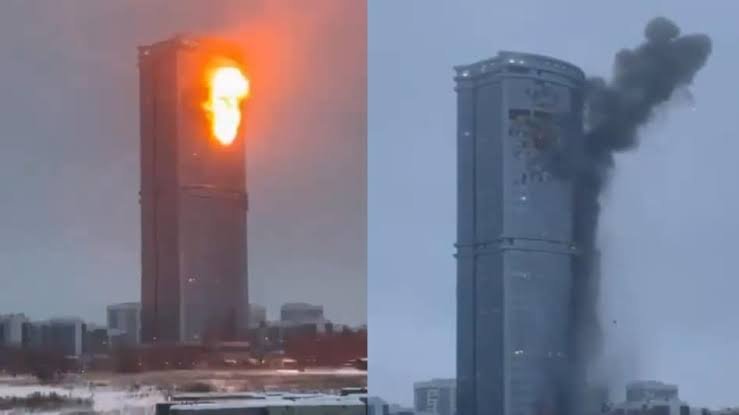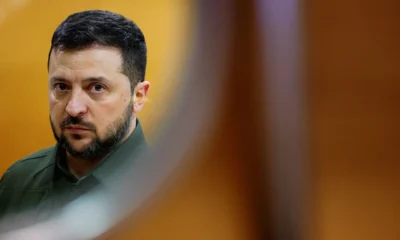In an unprecedented escalation, Ukraine brought the war to Russia’s doorstep on Saturday morning, launching drone attacks that targeted residential buildings in Kazan, the capital of Tatarstan, located over 600 miles (1,000 kilometers) from the front lines.
Local authorities confirmed that eight drones struck the city, with six hitting residential buildings, one impacting an industrial facility, and another being intercepted over a river. A video shared on local Telegram channels shows a drone crashing into the upper floors of a high-rise building.
No casualties were reported, but the attacks caused significant disruptions. Flights at Kazan’s airport were temporarily halted, and all public gatherings scheduled for Saturday and Sunday were canceled.
But the question that is being asked – why was the 15th floor of the particular building targeted?
The drones appeared to target key strategic locations, including high-rise residential buildings.
Analysts suggest the specific targeting of the 15th floor of one building could indicate intelligence suggesting the presence of critical assets. Some reports speculate that the floor may have housed personnel or equipment linked to military or industrial operations, making it a high-value target.
The attacks, spaced approximately 50 minutes apart, not only hit residential areas but also industrial sites of strategic importance.
Escalation on Both Sides
The Kazan attack came just a day after a Ukrainian strike on the Kursk border region in Russia, which reportedly used U.S.-supplied missiles and killed six people, including a child. In response, Moscow launched a massive overnight drone assault on Ukraine, with 113 drones deployed. Ukrainian officials reported that 57 drones were shot down, while another 56 were likely neutralized through electronic jamming.
In Ukraine’s Kharkiv region, eight people were injured during Friday night drone strikes, adding to the escalating toll on both sides.
The Kazan strike reflects Ukraine’s intent to showcase its advanced drone technology and its ability to strike far from the battlefield. The high-profile nature of the attack on the 15th floor suggests it was chosen for its symbolic and psychological impact, signaling to Russia the precision and reach of Ukraine’s military capabilities.
At the same time, these attacks aim to undermine Russian morale by demonstrating vulnerabilities in regions previously deemed safe.
Emergency Declared in Kazan, Tatarstan
In the aftermath of the attacks, the Tatarstan Republic declared a state of emergency for government agencies and emergency response units.
“The head of Tatarstan has signed an order imposing a special emergency mode for government agencies and the Ministry of Emergency Situations. This status is necessary to swiftly handle the consequences of the attacks in accordance with the law,” said the press service of Tatarstan President Rustam Minnikhanov.
This state of emergency applies only to those involved in response efforts and does not affect the general population.

The Developing Story
Ukrainian President Volodymyr Zelenskyy declared on Saturday that Ukraine would persist in targeting Russian military assets with drones and missiles, though he refrained from explicitly referencing the recent strike on Kazan. Following the attacks, some residents in Kazan were evacuated—though Russian authorities withheld specific numbers—and all major public events in the area were canceled as a precaution.
Kazan International Airport, one of Russia’s busiest, was temporarily closed by the civil aviation authority Rosaviatsia but resumed operations later that day. According to the Russian foreign ministry, alongside the drones that struck an apartment block, three drones were intercepted, and three others were neutralized by air defense systems.
The attack on Kazan, located approximately 800 kilometers east of Moscow, occurred a day after Russian airstrikes on Kyiv killed one person and injured 13, and a separate Ukrainian attack in the Russian border region of Kursk claimed five lives.
Zelenskyy also disclosed on Saturday a rare public acknowledgment of a meeting with CIA Director William Burns in Ukraine. While Zelenskyy noted that he and Burns have met multiple times during the conflict, their discussions have typically been kept confidential.
Sharing a photograph on Telegram of the two shaking hands before Ukraine’s state crest, Zelenskyy stated, “Bill Burns paid his last visit to Ukraine as CIA director. I am grateful for his help throughout the war. Usually, such meetings are not publicly reported, and all our meetings—in Ukraine, Europe, America, and elsewhere—were conducted without official announcements.”
Notably, Burns is set to step down as CIA director as U.S. President-elect Donald Trump appoints a successor.
Meanwhile, Russia’s defense ministry reported the capture of a new village, Kostiantynopolske, near the strategic city of Kurakhove in eastern Ukraine. The village, located about 10 kilometers southwest of Kurakhove, represents another advance for Russian forces in the region.
Meanwhile in London, the Russian embassy condemned the UK’s planned transfer of over £2 billion ($2.5 billion) to Ukraine, backed by frozen Russian assets, calling it a “fraudulent scheme.” In October, Britain announced a £2.26 billion loan to Ukraine, part of a broader Group of Seven initiative utilizing frozen Russian central bank funds to support Ukraine’s military and infrastructure rebuilding.
UK Defense Minister John Healey specified that the funds would be allocated exclusively for military purposes, including the development of drones with ranges exceeding some long-range missiles.
The Last Bit
The Kazan attack signals a turning point in the conflict, with Ukraine pushing the boundaries of its offensive capabilities. Russia’s response is likely to escalate, raising questions about the implications of such targeted strikes and the future trajectory of the war.
As both sides intensify their actions, the conflict continues to reverberate far beyond the immediate battlefield, threatening to reshape the dynamics of the war in unforeseen ways.














